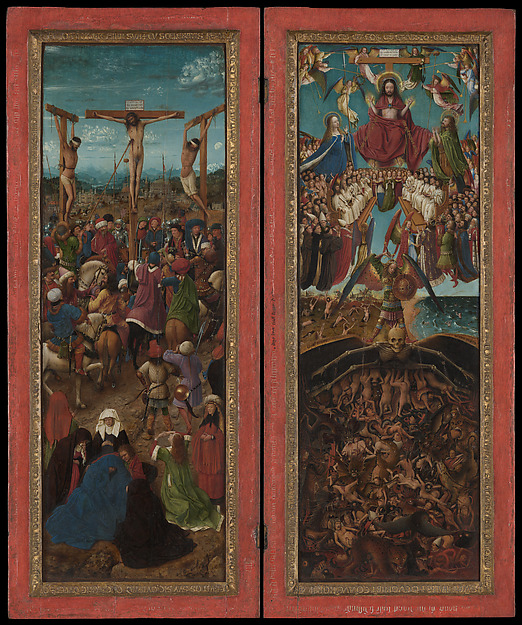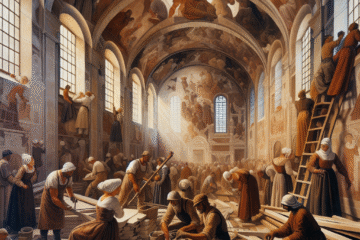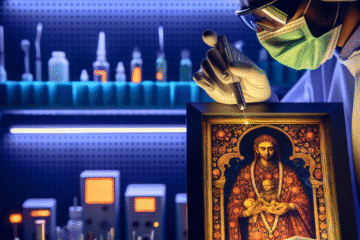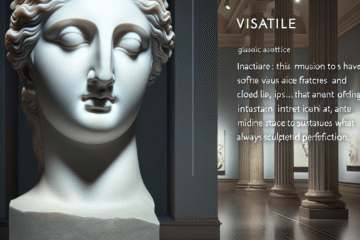
Image title: The Crucifixion; The Last Judgment
Medium: Oil on canvas, transferred from wood
Date: ca. 1436–38
Source:
The Met Collection
“
The cause is hidden. The effect is visible to all.
”
— Ovid
The Unseen Studio: Unearthing the Hidden Labor Behind Masterpieces
Introduction: Shadows Behind the Canvas
When we stand before a painting in a museum and revere its genius, our attention instinctively gravitates toward the name glowing on the wall label—da Vinci, Raphael, Titian, Picasso. These names have become shorthand for brilliance, representing solitary creative genius. But beneath the visible layers of art history lie legions of skilled hands: studio assistants, apprentices, craftsmen, and artisans whose contributions remain largely invisible. This blog post illuminates the hidden labor that has flourished behind the curtain from the Renaissance to contemporary art, revealing a rich, collaborative tradition often masked by the myth of singular authorship.
1. The Renaissance Workshop: Crafting Collective Genius
The archetypal image of the Renaissance workshop teems with activity: apprentices grinding pigments, journeymen sketching under the master’s direction, and specialists rendering backgrounds or draperies. Artists like Botticelli and Verrocchio operated studios that functioned more like collaborative enterprises than isolated sanctuaries of creativity. Leonardo da Vinci himself began as an apprentice in Verrocchio’s workshop, likely painting portions of his master’s works.
Guild systems codified artistic training and production, emphasizing a communal knowledge system. Many commissions, especially large frescoes or altarpieces, were too grand for any one artist to complete alone. Despite their contributions, the names of these supporting figures faded into anonymity, overshadowed by the masters they served.
2. Baroque Ambitions and Studio Empires
With the advent of the Baroque period, the scale and drama of art intensified. Studios evolved from small workshops into complex art factories. Peter Paul Rubens’ Antwerp workshop epitomized this transformation. Rubens would sketch compositions and oversee their execution by a staff of highly skilled painters and draftsmen. His protégés, including Anthony van Dyck, created masterpieces under his brand.
This system blurred the line between originality and execution. Questions arose about authorship—was a work truly Rubens’ if his brush barely touched the canvas? Yet, the economic and temporal demands of high-status commissions necessitated such collaboration. These collective entities laid the foundation for modern notions of branding and mass production in art.
3. The Academic Machine and Industrial Influence
During the 18th and 19th centuries, art academies institutionalized artistic training and fostered a hierarchy of genres and processes. Studios remained collaborative, yet emphasized individual flair within academic constraints. At the same time, the Industrial Revolution introduced new technologies—synthetic pigments, printmaking presses, photography—that expanded creative possibilities and altered studio hierarchies.
This era also saw the rise of the master’s atelier as a pedagogical hub. In France, Jean-Léon Gérôme mentored countless students at the École des Beaux-Arts, blending strict academicism with dropout innovation. Behind the finished artworks stood technical hands—engravers, colorists, engineers—who enabled both replication and innovation, yet remained footnotes in art historical narratives.
4. The Modernist Break and Myth of the Isolated Genius
The 20th century ushered in Modernism and with it, perhaps the most enduring myth in art—the solitary genius. Pablo Picasso, Jackson Pollock, and Marcel Duchamp are often portrayed as lone wolves of creative rebellion. Yet, even Pollock had his inner circle, including his wife and fellow artist Lee Krasner, who provided critical feedback and managed his career. Picasso collaborated with printmakers and ceramicists whose labor brought his ideas to life.
Movements such as the Bauhaus challenged traditional hierarchies by integrating design, architecture, and fine art, fostering interdisciplinary collaboration. However, the cult of personality persisted. Assistants, co-creators, and technicians remained unnamed, hidden behind the spectacle of the signature and the legend.
5. Contemporary Studios: From Factory to Network
Today, large-scale contemporary artists like Jeff Koons, Takashi Murakami, and Ai Weiwei command complex, global operations that resemble corporations. Koons famously does not physically make his works; instead, his studio employs dozens of artisans, fabricators, and managers to execute his ideas with mechanical precision. Murakami combines digital design, traditional Japanese painting, and mass production in a seamless artistic ecosystem.
New media and digital art further complicate authorship. Generative art, NFTs, and AI-assisted designs often involve teams of coders, designers, and curators. The digital atelier may not reside in a physical space, but in shared cloud folders and virtual whiteboards. Authorship now becomes a question of intent and direction rather than mere manipulation of materials.
Conclusion: Toward a Renewed Vision of Authorship
Art history has long celebrated iconic names, often at the expense of those who shaped the very fabric of artistic creation. As we recover these hidden lineages, we gain not only a fuller understanding of how masterpieces come into being but also challenge the very notion of the ‘genius’ as a solitary figure. Art, like all human endeavors, is the product of shared effort, layered knowledge, and invisible labor. Recognizing this enriches our appreciation of not just the finished work, but the unseen studio from which it emerged.

Image description:
Treppenabgang zum Atelier der Malerin Gabriele von Glasow im Souterrain des Hauses Podbielskistraße 26 …
License:
CC BY-SA 4.0
Source:
Wikimedia Commons
Useful links:


